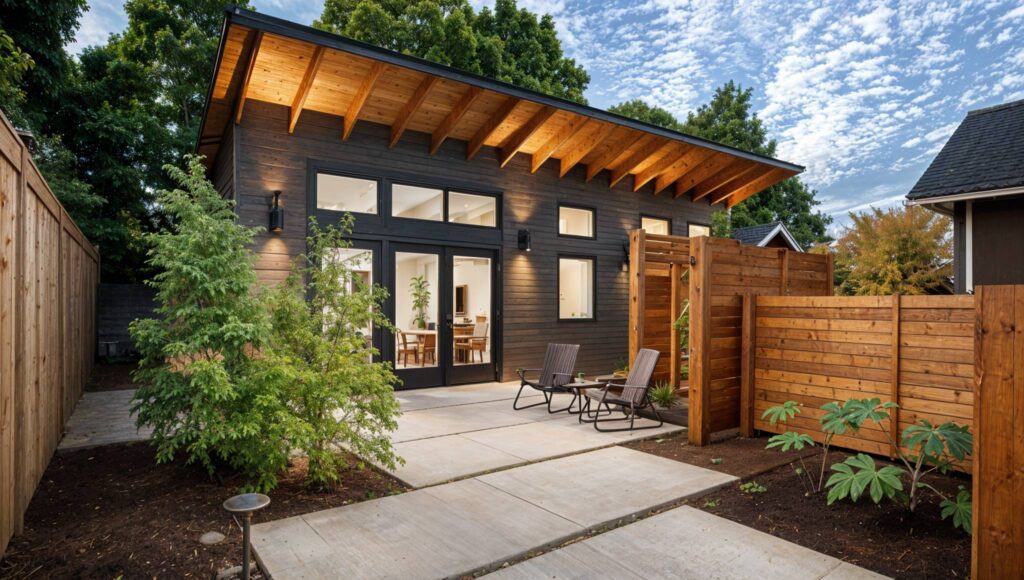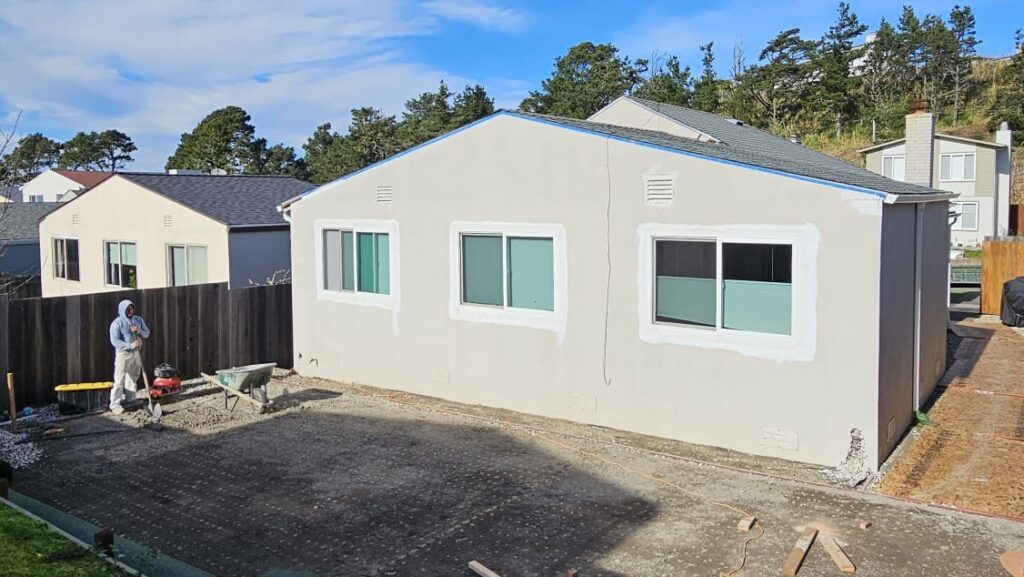Considering building an ADU for a home office? Wondering if it’s a savvy real estate investment? Let’s delve into the pros and cons. On one hand, an ADU can boost property value, generate rental income, and provide a dedicated workspace. However, factors like construction costs, zoning regulations, and market demand should be carefully weighed. By converting space into a home office, you can enjoy convenience and separation from home life, enhancing productivity. But is the financial outlay worth the potential gains? Let’s explore whether creating an ADU for a home office is a smart move in the realm of real estate investments.
Understanding ADUs
Types of ADUs
Accessory Dwelling Units (ADUs) are secondary housing units located on a single-family residential lot. They are also known as granny flats, in-law suites, or backyard cottages. ADUs can take various forms, including detached units, garage conversions, and basement apartments. These units come with their own kitchen, bathroom, and living space.
Garage conversions involve transforming an existing garage into a living space with all the necessary amenities. Detached units are standalone structures built separately from the main house. Basement apartments are created by converting the lower level of a home into a separate living area. ADUs provide homeowners with additional living space while offering potential rental income opportunities.
Urban Housing Trends
The rise of ADUs has been particularly notable in urban areas facing housing shortages. Cities like Portland and Los Angeles have seen a surge in ADU construction as a response to the growing demand for affordable housing options. Many ADUs are being built to accommodate the increasing population density in urban centers.
Urban planners and policymakers view ADUs as a viable solution to address housing affordability issues and promote sustainable urban development. By allowing homeowners to create additional rental units on their properties, ADUs help increase housing supply without the need for large-scale new construction projects. This trend aligns with the push towards more efficient land use and denser urban environments.
Benefits of ADUs
- Increased Property Value: Adding an ADU to a property can significantly increase its market value.
- Rental Income: Homeowners can generate extra income by renting out their ADU to tenants.
- Multigenerational Living: ADUs provide flexibility for multigenerational families to live together while maintaining privacy.
- Affordable Housing: ADUs offer more affordable housing options in high-demand urban areas.
Financial Viability
Construction Costs and ROI
Building an ADU involves various costs, including design and labor expenses. On average, constructing an ADU can cost between $90,000 to $150,000. The return on investment (ROI) for an ADU primarily depends on rental income and property value appreciation. Factors like location and materials used can significantly influence construction costs.
Pros:
- Potential for additional rental income.
- Increased property value over time.
Cons:
- Initial high construction costs.
- Maintenance expenses may impact ROI.
When considering the rental income potential of an ADU, it is crucial to research average rental rates in different regions. Rental rates for ADUs can vary, impacting the overall income generation. Understanding seasonal fluctuations in rental demand is essential for predicting income stability. Owners must weigh the benefits of short-term rentals for higher income in peak seasons versus long-term rentals for consistent cash flow.
Property Value Increase
Adding an ADU to a property can significantly enhance its market value. Statistics show that properties with ADUs experience an average increase in value ranging from 20% to 30%. Buyers often prefer properties with ADUs due to the additional living space or rental income potential. In competitive real estate markets, having an ADU can give a property a competitive edge and attract more potential buyers.
Factors Influencing Property Value Increase:
- Location of the property.
- Quality of construction and design.
- Demand for rental properties in the area.
Regulatory Considerations
Local Regulations and Permits
Local regulations play a crucial role in the construction of Accessory Dwelling Units (ADUs). Zoning laws typically dictate where ADUs can be built within a property. It is essential to obtain permits from the local authorities before commencing any ADU project. Failure to comply with these regulations can result in penalties or even demolition orders.
- Obtaining permits for an ADU involves ensuring compliance with setback requirements, parking regulations, and size limitations.
- Zoning laws may restrict the size or height of an ADU, affecting its design and construction.
- Non-compliance with local regulations can lead to fines, legal issues, and delays in completing the project.
Market Demand Analysis
Analyzing the current housing demand trends is vital when considering an ADU investment. Factors such as population growth, urbanization, and lifestyle changes influence the need for additional housing options like ADUs. Demographic shifts, including an aging population and the rise of remote work, contribute to the increasing appeal of ADUs.
- Research indicates a rising demand for smaller, more affordable housing solutions, making ADUs an attractive option for homeowners.
- The competition in the rental market should be carefully evaluated to determine the potential rental income from an ADU.
- Understanding market dynamics helps in assessing the long-term profitability of investing in an ADU.
Property Suitability
Assessing a property’s suitability for an ADU involves considering various factors. The physical characteristics of the property, such as lot size, existing structures, and access to utilities, significantly impact the feasibility of constructing an ADU. Property owners must also navigate challenges related to zoning restrictions and design constraints.
- Lot size plays a crucial role in determining if there is sufficient space for an ADU without violating zoning laws.
- Existing structures on the property may need modifications to accommodate an ADU or may limit its construction.
- Access to utilities like water, electricity, and sewage systems is essential for the functionality of an ADU.
Design and Functionality
Effective Home Office Layout
Creating a functional home office in an ADU involves strategic planning and thoughtful design choices. Maximize productivity by incorporating ergonomic furniture and efficient storage solutions. Consider the layout to ensure a seamless workflow and easy access to essential items.
To enhance productivity and comfort, prioritize natural light in the workspace. Position the desk near windows to benefit from daylight and reduce eye strain. Soundproofing is crucial to minimize distractions and create a quiet environment for focused work.
Optimize space and functionality with strategic furniture arrangements. Choose multipurpose pieces that serve dual functions, such as desks with built-in storage or foldable tables. Utilize technology like wireless printers and smart lighting to streamline tasks.
Versatility and Flexibility
An ADU offers more than just a home office; it presents a versatile space that can adapt to various needs. Beyond work, ADUs can serve as guest accommodations, rental units, or even a private retreat. Their flexibility makes them a valuable long-term investment for changing family dynamics.
As families evolve, ADUs provide the flexibility to accommodate new living arrangements. Whether it’s housing aging parents, hosting guests, or generating rental income, these units offer endless possibilities. Their adaptability ensures they remain relevant and useful over the years.
Explore creative design ideas to maximize the versatility of an ADU space. Consider convertible furniture, movable partitions, or modular layouts that can easily transform the space based on changing needs. This adaptability adds significant value to the property.
Market Appeal Design Tips
Boost the market appeal of your ADU with attractive exterior and interior designs. Enhance curb appeal by landscaping the surroundings and adding charming details like window boxes or a welcoming entrance. Aesthetically pleasing exteriors attract potential renters or buyers.
Maintain a cohesive design by aligning the ADU’s aesthetic with the main house. Choose complementary colors, materials, and architectural styles to create a harmonious look across the property. Consistency in design enhances the overall appeal of the real estate.
To attract tenants or buyers, consider adding modern amenities like high-speed internet, energy-efficient appliances, or outdoor living spaces. These features increase desirability and set your ADU apart in a competitive market.
Challenges and Risks
Construction and Maintenance Costs
Building an ADU for a home office can incur various challenges and risks, especially concerning construction and maintenance costs. Ongoing expenses include utilities like electricity, water, and gas, which can fluctuate based on usage. Repairs, such as fixing plumbing or electrical issues, also contribute to the overall cost of owning an ADU. Budgeting for these expenses is crucial to avoid financial strain. Unexpected costs during and after construction, such as material price increases or unforeseen structural problems, can impact the project’s budget significantly. Opting for energy-efficient designs can help reduce long-term operational costs by lowering utility bills.
- Ongoing maintenance costs: utilities, repairs
- Importance of budgeting for unexpected expenses
- Potential for energy-efficient designs to reduce operational costs
Legal and Regulatory Hurdles
Navigating legal and regulatory hurdles is another significant concern when considering building an ADU for a home office. Common legal issues that may arise include zoning restrictions, building code compliance, and permit requirements. Consulting with legal experts is essential to ensure compliance with complex regulations that vary by location. Changes in legislation related to ADU development could affect property owners’ ability to construct additional units on their land.
- Common legal issues: zoning restrictions, building codes
- Importance of consulting legal experts
- Potential legislative changes impacting ADU development
Tenant Management Issues
Effective tenant management is key to the success of renting out an ADU for a home office. Implementing thorough screening processes helps in selecting reliable tenants who will maintain the property well. Common challenges related to tenants include negotiating lease agreements, handling rent payments, and resolving conflicts peacefully. Maintaining a positive landlord-tenant relationship fosters trust and ensures long-term occupancy in the ADU.
- Strategies for managing tenants effectively
- Common tenant-related challenges: lease agreements, conflict resolution
- Benefits of maintaining a good landlord-tenant relationship
Maximizing Returns
Funding and Financing Options
When considering investing in an ADU for a home office, exploring various financing options is crucial. One common choice is obtaining loans or grants specifically tailored for ADU construction. These financial resources can ease the burden of upfront costs and make the investment more feasible for homeowners. However, it’s essential to weigh the pros and cons of using home equity lines of credit versus traditional mortgages. While home equity lines of credit offer flexibility, they come with variable interest rates that can increase over time, impacting long-term financial planning. On the other hand, traditional mortgages provide stability with fixed interest rates but may involve stricter qualification requirements.
Pro and Con:
- Pro: Loans and grants reduce initial financial strain.
- Con: Home equity lines of credit have fluctuating interest rates.
Exploring potential government incentives or programs supporting ADU development is another avenue to consider. Some local authorities offer tax incentives, fee waivers, or low-interest loans to encourage homeowners to invest in ADUs. By taking advantage of these programs, property owners can further maximize their returns while contributing to the community’s housing needs.
Marketing and Tenant Strategies
To ensure a successful return on investment, effective marketing strategies are essential for attracting tenants to an ADU. Utilizing online listings on real estate platforms and leveraging social media channels can significantly expand the reach to potential renters. Highlighting the unique features and benefits of the ADU through compelling descriptions and high-quality images can capture the interest of prospective tenants. Staging the ADU to showcase its full potential and investing in professional photography can enhance its appeal, increasing the chances of securing quality tenants.
Benefits of Offering Flexible Lease Terms:
- Attract a wider range of tenants with varying preferences.
Long-Term Planning Tips
Looking beyond the immediate returns, property owners should engage in long-term planning to maximize the benefits of their ADU investment. Considering future needs and potential changes in family dynamics is crucial when designing the ADU layout and amenities. Regularly monitoring local market conditions and staying informed about evolving regulations can help property owners adapt their rental strategies to optimize returns.
Creating a comprehensive maintenance schedule is vital to ensure the longevity and value of the ADU. By proactively addressing repairs and upgrades, property owners can maintain a desirable living space for tenants, ultimately safeguarding their investment in the long run.
Final Remarks
Considering the financial benefits, regulatory aspects, design flexibility, challenges, and potential returns discussed, investing in an ADU for a home office can be a lucrative real estate decision. By understanding the nuances and carefully navigating through the considerations highlighted, you can maximize the value of your property while creating a functional workspace that adds to your quality of life. Remember, thorough research, strategic planning, and adherence to local regulations are key to a successful ADU investment.
Investing in an ADU for a home office can not only enhance your property’s value but also provide you with a dedicated workspace that meets your specific needs. Take the insights shared into account, weigh the pros and cons carefully, and consider consulting with professionals to make informed decisions tailored to your situation. Your future home office in an ADU could be closer than you think!
Frequently Asked Questions
1. Is an ADU a good real estate investment for a home office?
Building an ADU for a home office can be a wise investment. It adds value to your property, provides a dedicated workspace, and offers rental income potential.
2. What are the financial benefits of constructing an ADU for a home office?
An ADU can generate additional rental income, increase property value, and potentially provide tax benefits. It also offers flexibility in terms of usage, allowing for personal or rental purposes.
3. Are there any regulatory considerations to keep in mind when building an ADU for a home office?
Regulations vary by location, so it’s crucial to research zoning laws, permits, and building codes before constructing an ADU. Ensure compliance with local regulations to avoid any legal issues.
4. How can the design and functionality of an ADU enhance a home office setup?
Designing the ADU with ample natural light, proper insulation, and functional layout can create an ideal work environment. Consider features like high-speed internet connectivity and ergonomic workspaces for productivity.
5. What challenges and risks should be considered before investing in an ADU for a home office?
Potential challenges include construction costs, maintenance expenses, and finding suitable tenants. Risks such as changes in rental demand or market conditions should also be evaluated before making the investment.
6. How can one maximize returns from an ADU built for a home office?
To maximize returns, optimize the design for rental appeal, market the space effectively, set competitive rental rates, and maintain the property well. Consider long-term rental agreements or short-term rentals like Airbnb for higher returns.
Elevate Your Home with Red White & Blue Construction!
Thinking about framing solutions for your house? Look no further! Embark on a transformative journey where your home in Lafayette, CA, becomes the sanctuary you’ve always dreamed of. With Red White & Blue Construction, every wall and corner is meticulously framed to ensure your house is as structurally sound as it is beautiful. Dive into advanced framing techniques that provide the perfect foundation for your home, or explore innovative designs that maximize space and enhance functionality. Our reputation in the Bay Area stands as a testament to our commitment, expertise, and the unparalleled standards we uphold. We’re more than just licensed contractors; we’re the architects of your dream home. With our transparent pricing and exceptional client engagement, you’re not just building; you’re reimagining, redefining, and revitalizing your space. Choose Red White & Blue Construction. Craft the next chapter of your home story. Frame Your Home with Excellence and reach out to us today!
Disclaimer
The materials available on this website are for informational and entertainment purposes only and not to provide advice. You should obtain advice concerning any particular issue or problem from a professional. You should not act or refrain from acting based on any content included in this site without seeking legal or other professional advice. The information presented on this website may not reflect the most current building developments. No action should be taken in reliance on the information on this website. We disclaim all liability concerning actions taken or not taken based on any or all of the contents of this site to the fullest extent permitted by law.





